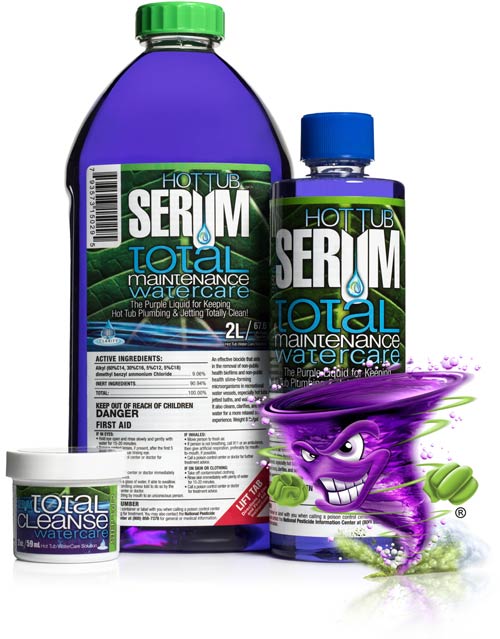Not long after you bought your hot tub, or perhaps while you were discussing your purchase with your hot tub salesperson, you had to decide how you planned to keep your spa water safe and clear while also soaking in it. Our Serum Total Maintenance (and Swim Spa Serum) is a back-up or secondary sanitizer. It is formulated to ensure any deficiencies with your primary sanitizer do not prevent your safe use and enjoyment of your hot tub. However, in this blog I will discuss your primary sanitizer options for our spa.
One very important note is that all primary sanitizers kill free-swimming bacteria and other pathogens in your spa. They DO NOT kill the bacteria that builds up inside your spa’s plumbing as biofilm. Removing & killing the bacteria in biofilm requires our spa purge, Serum Total Cleanse. You should purge your spa no less than once a year.
Chlorine & Bromine
The most common sanitizers for spas are chlorine (Cl) and bromine (Br). Both are in a group of elements called halogens. Iodine (I) is another member of this halogen group which has been commonly used as an antiseptic for many decades.
However, the actual sanitizer is not chlorine or bromine. Rather, the sanitizers are weak acids called hypochlorous acid and hypobromous acid. They are formed when either chlorine or bromine are dissolved in water.
Their popularity comes from the fact that they are not only highly effective as sanitizers but also very effective oxidizers. The first, sanitizing, means they kill all pathogens that might be found in a spa. The second, oxidizing, means the dead pathogens are broken down into much smaller molecules and essentially evaporate from your spa, hence removing them from your spa water.
Metallic Ion
Most ion-based sanitation systems are based on the silver ion. Though a few are based on copper ions, copper is more commonly used as an algaecide. Algae is often an issue in pools but rarely an issue in spas.
Ion systems are always 2-part because though silver has antimicrobial properties, the EPA will not certify ion-based systems for pool and spa use without an associated halogen sanitizer. They will use less of the halogen, but they are still paired with either chlorine or bromine.
Salt Systems
Salt Systems are actually also halogen based; either chlorine or bromine. The difference is that rather than continually adding chemicals to your spa, a Salt System spa will have 3 – 8 lbs. of salt (either sodium chloride or sodium bromide) in the water that is continuously being converted to either hypochlorous acid or hypobromous acid. These mild acids eventually convert back to the salt hence, once adding the salt, very little additional chemical is needed to maintain your spa. Because you use much less chemical in your spa, you can often extend the time between spa refills to as much as a year. The salt also makes both the spa water and your skin feel softer.
UV Systems
UV Systems expose the water in your spa to ultraviolet light while running through a quartz tube. However, UV Systems are not actually sanitizing the water. They do not kill bacteria and other pathogens. What they do however is render pathogens sterile so that they cannot reproduce. Consequently, rather like ion-based systems, they are always paired with a halogen sanitizer, generally chlorine. They are also often paired with an ozone generator.
Ozone
Molecularly, ozone is O3, a highly unstable version of oxygen having a ½ life of about 20 minutes. The oxygen that you breath is O2.
Ozone Generators are used in the majority of mid and high-end spas. They come in two types; corona discharge (sometimes called plasma discharge) and ultraviolet light, though corona discharge generators are much more common. They produce ozone, a gas, by replicating nature as both lightning (a corona discharge) and ultraviolet light in the upper atmosphere produce ozone. However, ozone in your spa is also not a sanitizer because the concentration is very low and, as noted, it dissipates rapidly. Further, ozone must be dissolved into your spa water to be effective.
In your spa, ozone is an oxidizer. Above I noted that both chlorine and bromine are also oxidizers. However, neither have sufficient oxidizing ability to remove all the waste products in a spa, hence additional oxidizers are needed. One can be, and often is, ozone. Another is Potassium Monopersulphate, commonly called Non-Chlorine based Shock.
Biguanide
Finally, we come to the Biguanide Systems. The use of biguanide has a history in hospitals where is it a highly effective sanitizer. Some 20 years ago it was adapted for use in pools and spas. However, it is distinctly different from the systems I have previously discussed which are all compatible with each other. Biguanide is NOT compatible with any other sanitation system. Also, unlike all other sanitation systems, Biguanide Systems use hydrogen peroxide as an oxidizer. If you wish to use biguanide you MUST completely clean your spa of any previous sanitation system FIRST.
Biguanide systems do work but they are known to be rather tricky and quite intolerant of any deviation from their instructions for use.






